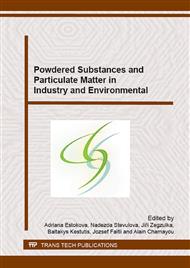p.71
p.77
p.88
p.94
p.102
p.108
p.114
p.121
p.130
Utilization of Crushed Glass Waste in Concrete Samples Prepared with Coal Fly Ash
Abstract:
This article is aimed on the study of glass bottle cullet influence on the compressive and flexural strength development of products prepared as the partial natural aggregate replacement by crushed glass waste. For this study, eight different mixtures containing coloured glass cullet as a full replacement of natural aggregate fractions 0/4, 4/8 and 8/16 mm and two comparative mixtures were prepared. In four of these mixtures, 25% of Portland cement were replaced by coal fly ash. After 7, 28 and 90 days of hardening, samples were tested on flexural strength and compression strength. Results showed, that specimens containing full replacement of fraction 8/16 mm of glass cullet reached the highest compressive strength 43.32 MPa corresponding to concrete strength class C 30/37. Partial cement replacement by coal fly ash leads to low compressive strength after 7, 28 and 90 days of curing. Use of coloured glass bottle cullet in concrete should not have negative impact on the strength characteristics of hardened concrete and should have positive effects for preparing quality fair-faced concrete surfaces.
Info:
Periodical:
Pages:
102-107
Citation:
Online since:
October 2015
Authors:
Keywords:
Price:
Сopyright:
© 2016 Trans Tech Publications Ltd. All Rights Reserved
Share:
Citation:


